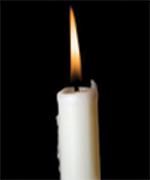|

There are many types of candles. Some of them are tea light (one time use, in small aluminium/plastic cups), floaters/floating candles (light enough to float on water), votive/prayer candles (typically white and 2” high, placed in candleholders grouped together, could be scented), taper or dinner candles (long, thin and elegant and placed in candlestick holders), pillar (solid, self-standing, wide and in different heights, some times with more than one wick), container/jar/filled candles (set in non-flammable and heat-resistant materials like glass and ceramic containers), luminaria/outdoor candles (for use outdoors, placed in sand), novelty/speciality candles (decorative and in unique shapes like birds), utility (simple and not decorative), birthday cake candles (small and coloured, one lit candle for each year of life completed is placed on the cake and blown out after making a wish), massage candles (fragrant, used to liquefy massage oil), and gel candles (transparent with decorative shaped wax pieces suspended within, they are produced from gelled mineral oils or gelled synthetic hydrocarbons).
Candles are usually made in India from paraffin wax (petroleum origin available in blocks, cylinders or flakes), entirely from beeswax (available in blocks and thin sheets) or more likely a blend of the two.
Standard commercial candles contain 60% paraffin, 10% beeswax and 30% stearin or stearic acid (can be of animal or plant origin) which is an essential additive in candle-making because it helps mould release by strengthening waxes, brightens colours, gives a smooth glossy finish and slows down the burning.
Scale wax (from insects – used for container candles only) or other waxes or a blend of them as used for taper and drip-less candles are also utilised. Some candles have small amounts of candelilla or carnauba palm waxes and decorative candles often use bayberry wax or wax myrtle (which have a distinctive aroma) derived from the fruit of the bayberry bush.
Scented soy wax candles are usually used in aromatherapy since they do not give off slimy soot. Other additives are mottling oil (petroleum by-product) or mineral oil, scents (could contain animal fixatives) and a plastic stiffening additive (wax-insoluble polymer or copolymer) which are required in the making of certain wax candles.
Craft makers suggest the use of egg shells as small moulds since they can be easily peeled off when the candle has set.
Eco-friendly shops often stock candles made of beeswax to which other decorative and scented ingredients like petals of flowers, leaves, silk threads, attars, essential oils and colours may have been added.
Some candles made abroad can contain spermaceti derived from the sperm whale. Some have soy and palm oils blended as ingredients. Non-drip taper candles and ones that burn without soot residues are usually more expensive.
Unfortunately candle manufacturers do not declare ingredients. So those who are interested in knowing the ingredients utilised need to inquire from the manufacturers of the products they wish to use.
|